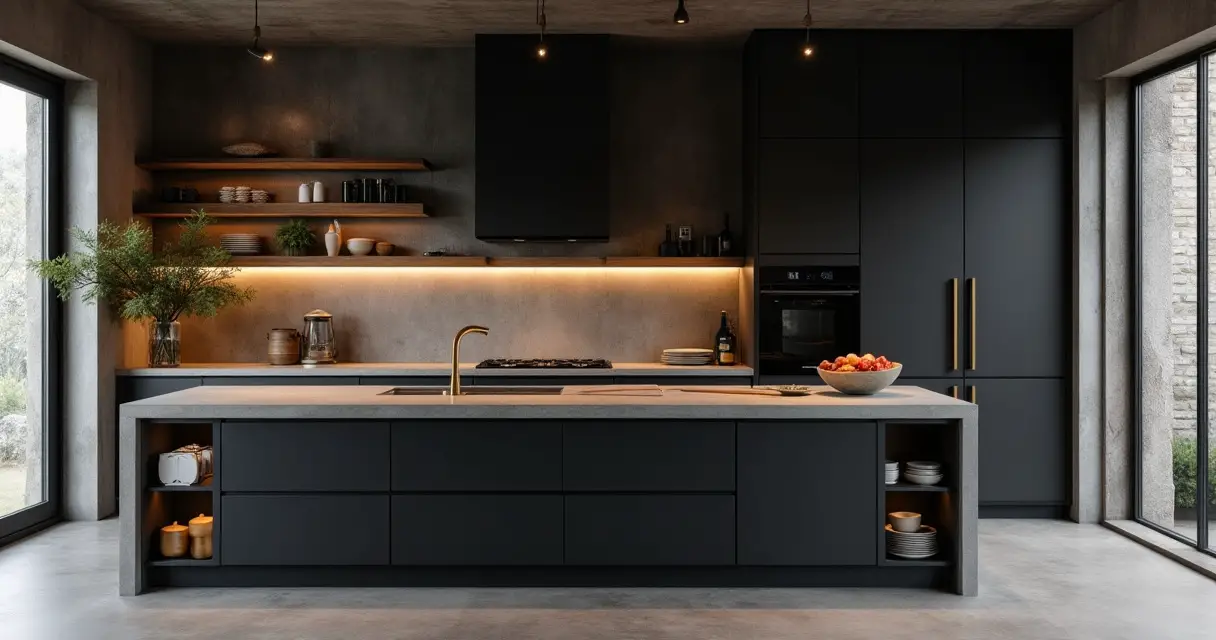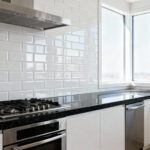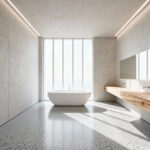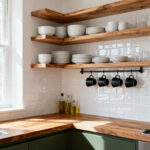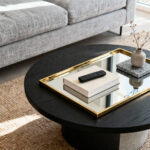You know the question I get asked more than any other about designing a truly luxurious home? It’s not about sourcing vintage Italian marble or the perfect paint color. It’s, “Can I really pull off a black kitchen?” People see these dramatic, stunning images, but they’re terrified the result will be a gloomy, light-sucking cave.
Here’s the truth: A black kitchen isn’t about a color. It’s about a mood. It’s confident, sophisticated, and deeply chic. But it’s also one of the easiest designs to get wrong. Most people think it’s just about choosing black cabinets. It’s not. It’s a delicate dance of light, texture, and proportion. Get it right, and you have a masterpiece. Get it wrong, and you have a mistake that’s very expensive to fix.
So, let’s talk about how to do it right. I’m going to tell you what actually matters, what’s just noise, and the little secrets that separate a passable black kitchen from a truly breathtaking one.
Foundational Concepts: Crafting Your Black Kitchen Vision
Before you even think about a single cabinet sample, you have to establish the soul of the space. This isn’t the boring part; it’s the most critical. This is where we lay the groundwork that ensures every decision that follows is the right one, creating a cohesive and deeply personal vision for your home.
1. Define Your Aesthetic: Modern, Classic, or Industrial?
Can we please talk about why everyone gets this wrong? They pick a style from a magazine without asking if it fits their home or their life. Last year, I had a client who was adamant about a hyper-minimalist, high-gloss black kitchen. But she lived in a 1920s Tudor-style home and had three small children. It was a complete mismatch. The starkness would have fought the home’s architecture, and the high-gloss finish would have been a battlefield of fingerprints.
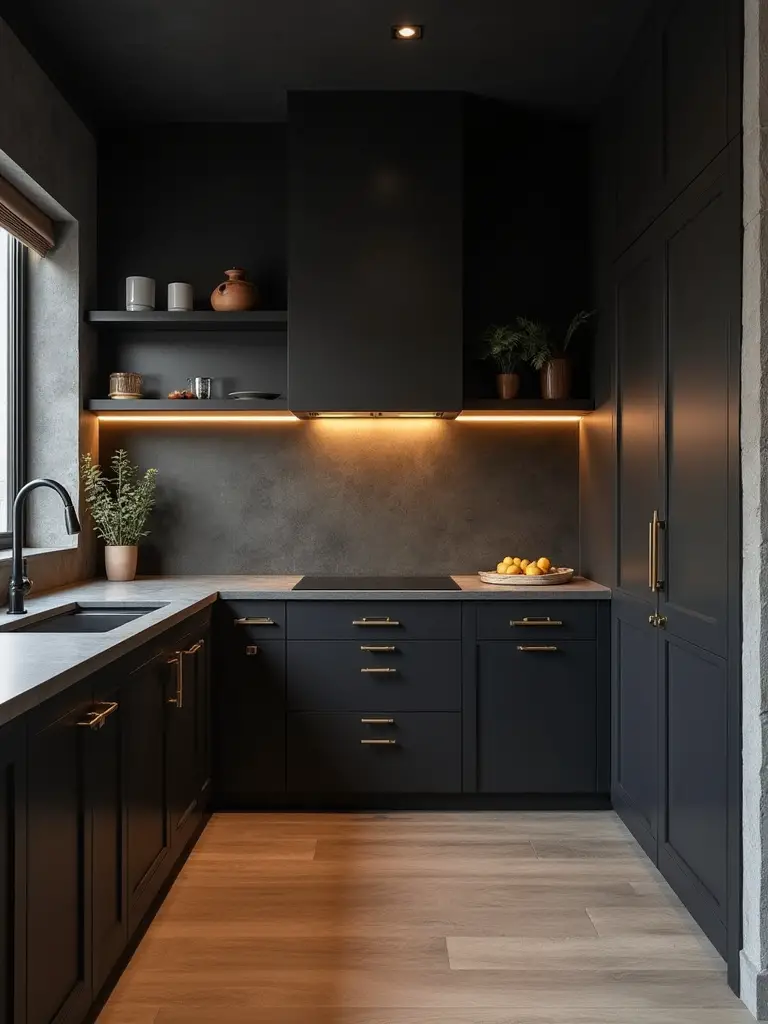
Your aesthetic isn’t just a label; it’s the operating system for every other choice. Are you seeking the clean, uninterrupted lines of a modern design, with its handleless matte cabinets? Or the timelessness of a classic approach, where black Shaker cabinets are warmed by brass hardware? Perhaps the raw, honest texture of an industrial look is what you crave. You must decide this first. It narrows your options and prevents that dizzying feeling of decision paralysis. A clear vision is the most effective budget-control tool I know.
So, let’s not make the mistake of choosing a look that doesn’t belong. Now, let’s talk about the single most important ingredient that will make or break your vision.
2. Assess Natural Light Levels to Enhance Black’s Depth Effectively
I used to think more light was always the answer. Then, I worked on a penthouse apartment that was essentially a glass box, flooded with sunlight from dawn until dusk. My client wanted black, but we quickly realized that direct, harsh sunlight on a high-gloss black surface creates a blinding glare, and on a matte surface, it washes out all the depth and nuance. The real trick isn’t just about having light; it’s about understanding the quality of your light.

Does your kitchen face north, receiving cool, consistent light all day? Or does it face west, getting blasted with warm, intense light in the afternoon? You need to become an observer. Watch how the light moves through the room. A black kitchen can’t be designed from a blueprint alone; it has to be designed in response to its environment. Black surfaces absorb light, so a poorly lit space will feel oppressive. But the right light, grazing across a textured black surface, will reveal its soul.
Once you’ve become a master of your home’s natural light, you can begin to add your own layers of contrast.
3. Strategize Contrasting Color Palettes for Visually Stunning Accents
Everyone thinks a black kitchen is… well, black. This is the biggest misconception, and it’s the fast track to a soulless, one-dimensional room. A truly sophisticated black kitchen is never just black. It’s about the strategic, intentional use of contrast to give the eye a place to rest and to create depth. Black needs a partner.
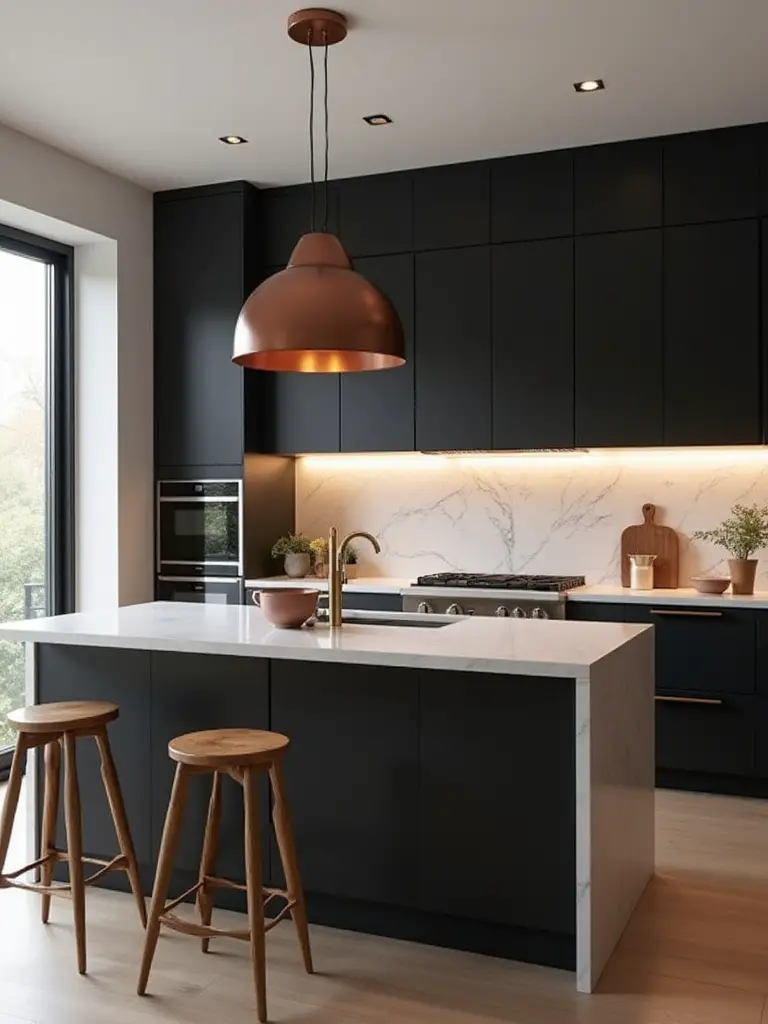
I’m not just talking about a white countertop. It could be a swath of warm, rift-sawn oak flooring that runs underfoot. It could be a breathtaking waterfall island in a richly veined Calacatta marble that becomes the centerpiece. Or it could be as simple as painting the ceiling a soft, luminous white to make the entire room feel taller. Without contrast, black becomes flat. With it, it becomes dramatic and architectural. Your job is to decide where to deploy that contrast for the greatest impact.
And the best place to start creating that impact is right at your feet.
4. Choose Cohesive Flooring Materials to Complement Dark Cabinetry
I once had a client who insisted on dark flooring with their new matte black cabinets. I tried to gently steer them away, but they were convinced it would be “moody and dramatic.” A month after installation, they called me in a panic. The room felt heavy, dark, and impossibly small. We had to spend a fortune on a complex lighting scheme just to make the space functional. It was a hard lesson for them to learn.

Your floor is the visual anchor for the entire kitchen. It is not the place to compete with the drama of the cabinets; it’s the place to support it. A lighter floor—whether it’s a pale European oak, a large-format porcelain tile in a soft grey, or even polished concrete—creates a foundation of light. It reflects brightness up onto the dark cabinetry, defines the room’s perimeter, and makes the black elements appear to float, giving them presence and importance. This single choice can make a kitchen feel twice as large and infinitely more luxurious.
With the foundation set, we can now add the most important layer of nuance.
5. Blend Black Finishes: Master Matte, Gloss, and Textured Surfaces
This is my favorite secret. If you learn only one thing from me today, let it be this: never use just one black finish. A kitchen designed with only matte black cabinets, countertops, and hardware will look like a black hole. It will have no dimension, no life. The real artistry comes from layering different sheens and textures.
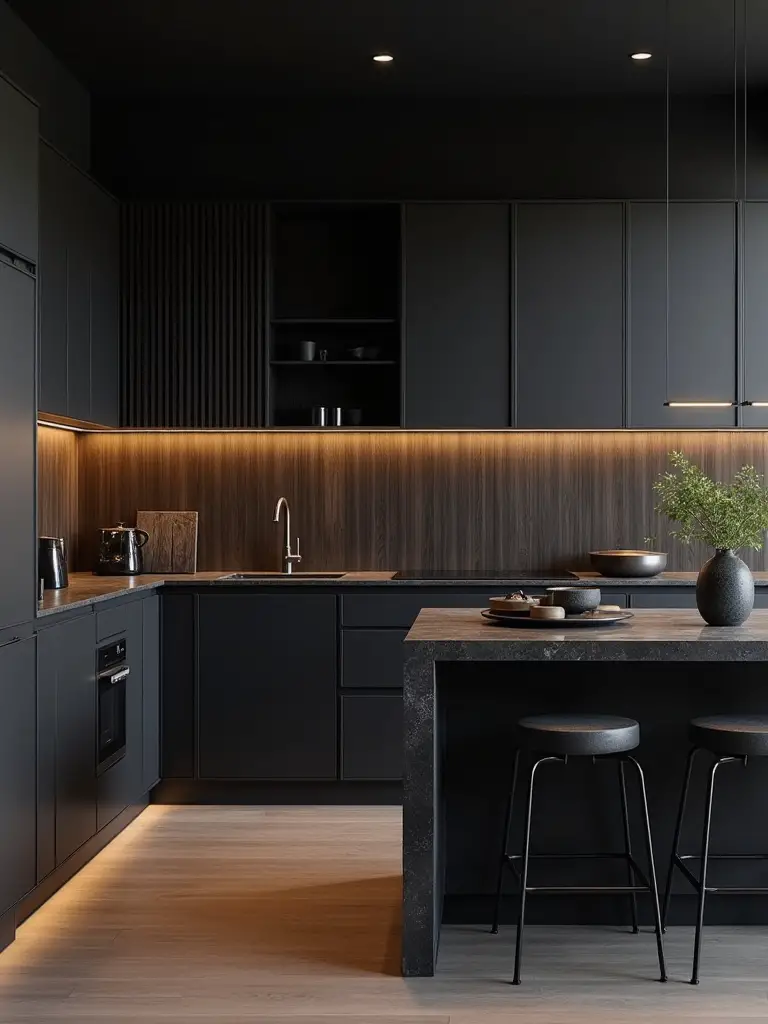
Think of it like getting dressed. You wouldn’t wear an outfit made entirely of the same fabric. You’d mix cashmere with silk, or leather with cotton. The same applies here. Pair the velvety, light-absorbing quality of matte black cabinetry with the reflective punch of a high-gloss black backsplash. Then, introduce a third texture, perhaps a honed black granite countertop that has a soft, leathery feel. This combination of matte, gloss, and texture creates a dynamic, tactile experience. It encourages light to dance around the room in interesting ways, adding a layer of sophistication that money alone cannot buy.
Core Elements: Selecting Key Components for Your Dark Design
Now we arrive at the heart of the matter—the major pieces that form the body of your kitchen. These are the big-ticket items, so the decisions here are about balancing breathtaking aesthetics with uncompromising function. This is where your investment truly shows.
6. Select Perfect Black Cabinetry Styles for Functional Elegance
Let’s be honest, the quality of your cabinet finish is everything. You can have the most beautiful design in the world, but if the finish is a cheap laminate or a poorly executed paint job, it will chip, fade, and look tired within a year. A luxury black finish, like a factory-applied lacquer or a high-quality catalyzed varnish, has a depth and durability that is simply unmatched. It’s the difference between a designer handbag and a knockoff.
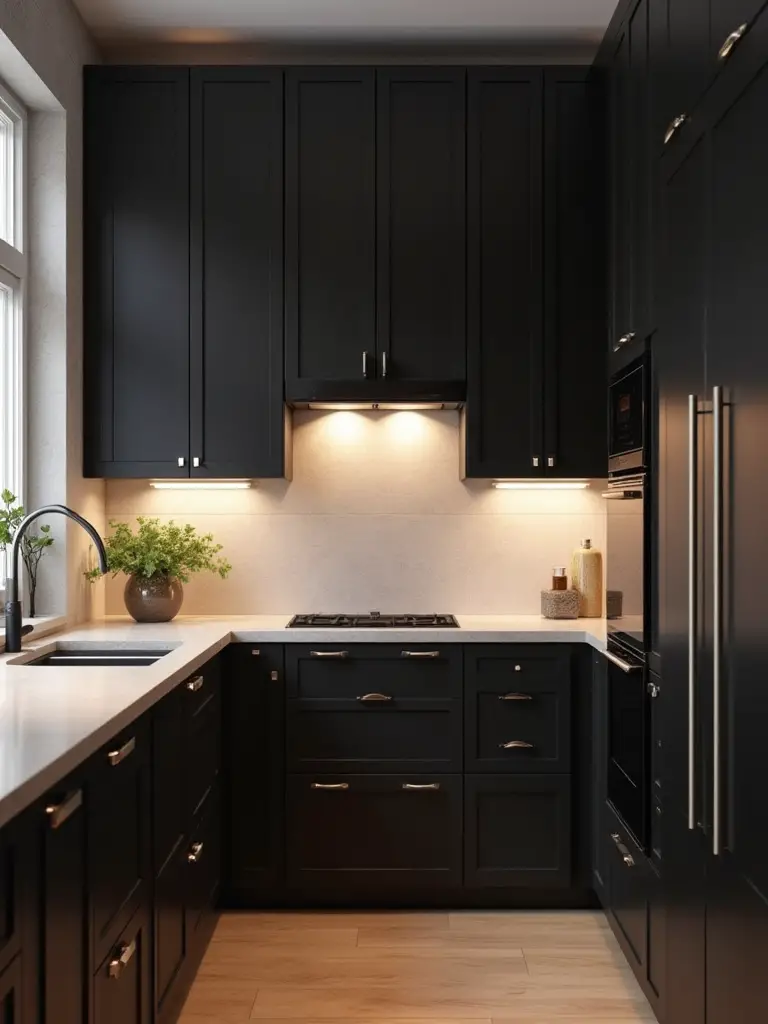
Beyond the finish, the style sets the tone. Sleek, flat-panel doors create a minimalist, architectural statement, perfect for modern homes. A classic Shaker door with its clean lines offers a timeless, transitional appeal that can be dressed up or down with hardware. And for a truly bespoke look, consider details like reeded or fluted panels, which add beautiful, rhythmic texture and a play of light and shadow. The right style should feel like a natural extension of your home’s character.
Now, let’s crown that beautiful cabinetry with the perfect working surface.
7. Pick Durable Countertop Materials that Complement Black Finishes
People are so afraid of maintenance. They’ve heard horror stories about marble staining and granite chipping, so they default to the “safest” option, which is often the most boring one. The truth is, high-quality natural stone, when properly sealed, is incredibly resilient. And there’s nothing that can replicate the soul and movement of a real slab of stone. For a black kitchen, a countertop with subtle texture is a must.

I adore using honed or leathered black granite. Unlike a polished finish, which can feel flat, these textures have a soft, tactile quality that begs to be touched. Soapstone is another brilliant choice; it has a milky, veined look and develops a gorgeous patina over time. If you crave the look of white marble but want absolute peace of mind, a high-quality quartz like Caesarstone or Silestone in a Calacatta or Statuario look is an excellent, nearly indestructible alternative. The key is to see the countertop not just as a work surface, but as the element that adds character and light to the entire composition.
With cabinets and countertops decided, it’s time to address the elephants in the room.
8. Integrate Seamless Black Appliances for a Cohesive Monochromatic Look
There is nothing—and I mean nothing—that ruins a high-end kitchen faster than a clunky appliance that doesn’t quite match. You can spend a fortune on Custom Cabinetry, but if your refrigerator sticks out three inches and its “black stainless steel” has a different sheen than your oven, the whole illusion is shattered. It’s the design equivalent of a beautiful evening gown worn with cheap running shoes.

The secret to a truly seamless look is panel-ready appliances. This is non-negotiable for a luxury result. You work with your cabinet maker to create custom panels that perfectly match your cabinetry, allowing your refrigerator and dishwasher to completely disappear into the design. For ovens and cooktops, choose models from brands that offer a true, deep black and are designed for a perfectly flush installation. This creates an uninterrupted, monolithic look that is impossibly chic and feels architectural rather than domestic.
And on that architectural canvas, we add the jewelry.
9. Choose Striking Metallic Hardware Finishes for Sophisticated Contrast
Hardware is where you get to have some fun. It’s the easiest thing to change, but it has a massive impact on the overall feeling of the space. Think of it as choosing between a classic pearl necklace and an edgy silver cuff—both are beautiful, but they tell a very different story. And against a black canvas, the hardware truly sings.
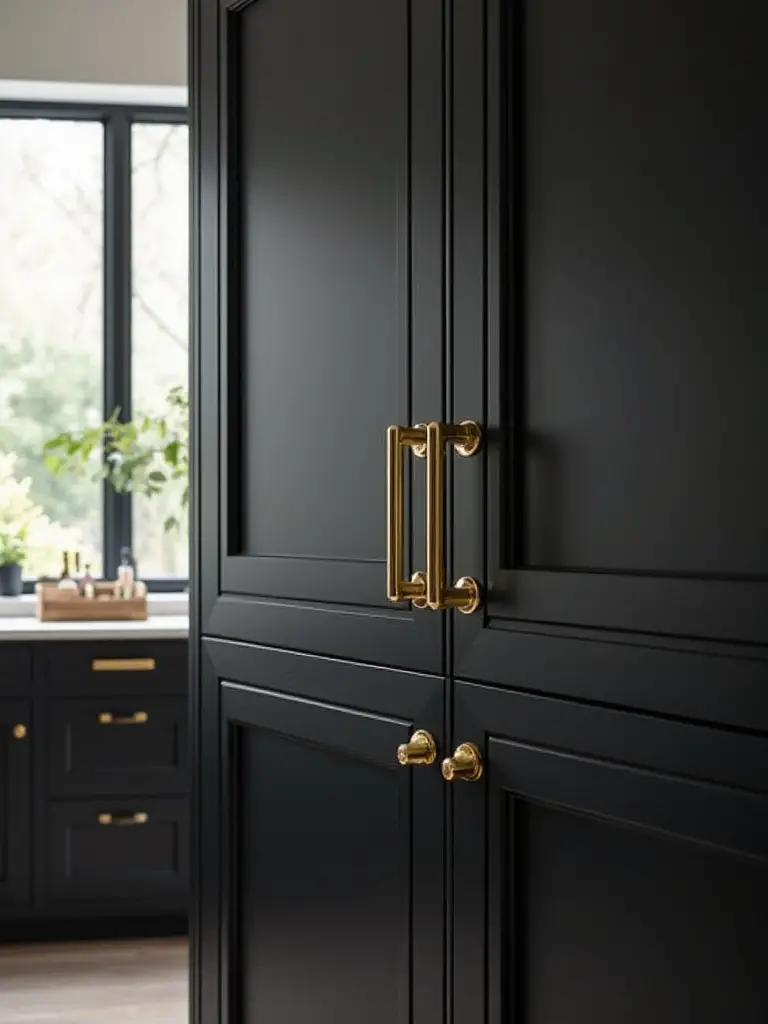
My personal preference is often an unlacquered brass. It has a beautiful, warm glow that provides the perfect contrast to the coolness of black, and it develops a rich, living patina over time. For a more modern or industrial look, brushed bronze or matte black offers a subtle, sophisticated touch. The key is to consider the undertone of your black. A cool, blue-black pairs beautifully with polished nickel or chrome, while a warmer, charcoal-black comes alive with brass or copper. Always order samples and hold them against your cabinet door in your kitchen’s light before you commit.
And just behind that beautiful hardware, you have an opportunity for major drama.
10. Design a Dramatic Black Backsplash for Bold Visual Impact
A backsplash isn’t just for protecting your walls from cooking splatters; it’s an opportunity to create a stunning focal point. Forget the standard 4-inch lip that comes with your countertop. In a luxury black kitchen, we want impact. Extending your countertop material up the wall for a full-height slab backsplash creates a seamless, incredibly high-end look that’s also a breeze to clean.

But you can also introduce a new texture here. A wall of handmade Zellige tiles in a glossy black offers an undulating, light-reflecting surface that is full of character. Black Marquina marble with its electric white veining provides incredible drama. My absolute pet peeve is using a bright white grout with black tile—it can look dated and busy. Instead, opt for a dark charcoal or black grout to create a sophisticated, monolithic look that lets the tile’s texture or shape be the star.
Depth and Dynamics: Lighting & Textural Enhancements
With the core structure in place, we now turn to the elements that give a black kitchen its soul. This is about adding layers that create warmth, depth, and a dynamic quality that shifts and changes with the light, transforming the room from a static design into a living, breathing space.
11. Implement Layered Lighting to Highlight Key Areas Effectively
If you walk away with one non-negotiable rule, it’s this: you cannot over-light a black kitchen. But it’s not about just throwing more wattage at it. You need a multi-Layered Lighting Plan, and every single light must be on a dimmer. Period. This is the difference between a showroom and a home.
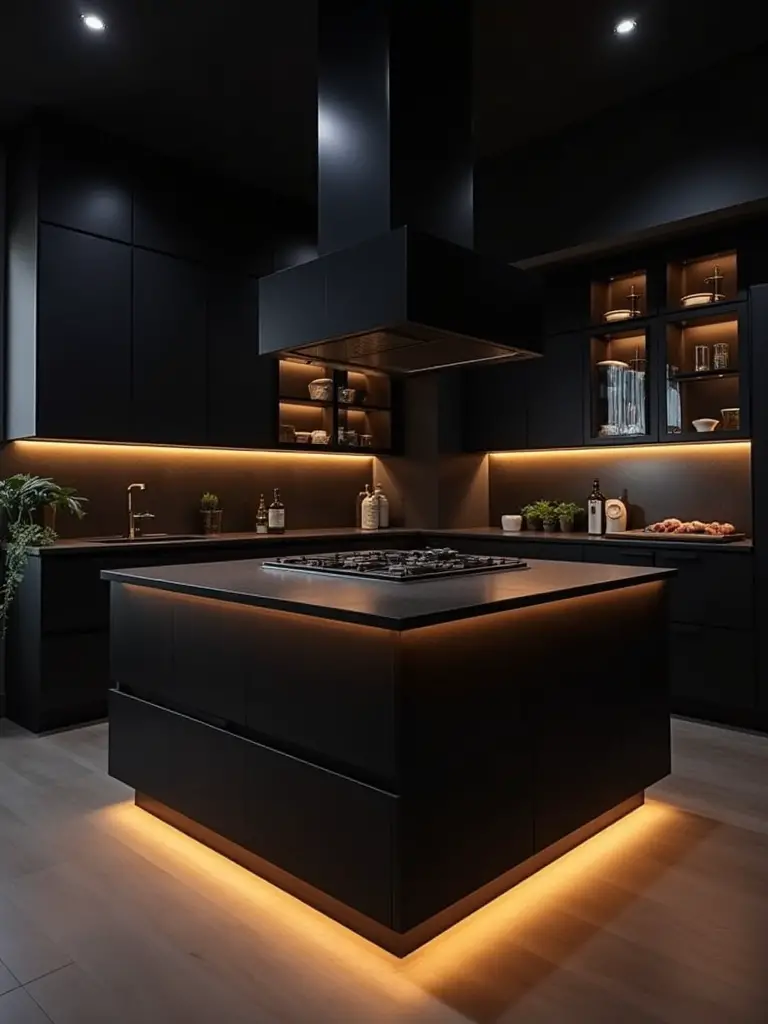
Your lighting plan needs three layers. First, ambient light: general, overhead illumination from recessed cans or a central fixture that fills the room. Second, task light: the workhorses of your kitchen. This means under-cabinet LED strips that illuminate your countertops so you can actually see what you’re chopping, and pendants over an island. Third, and this is the one most people forget, is accent light: small, targeted lights that highlight beautiful details, like a single spotlight on a piece of art or soft lighting inside a glass-fronted cabinet. With dimmers on all three, you can create a bright, functional workspace by day and a moody, atmospheric setting for dinner at night.
Once the lighting is right, you can introduce materials that will catch that light beautifully.
12. Incorporate Warm Wood Tones for Organic Balance and Coziness
A black kitchen, left to its own devices, can feel sterile and cold. Wood is the antidote. It brings an organic, grounding element into the space that instantly makes it feel more inviting and human. The warmth and natural grain of wood is the perfect counterbalance to the sleek, man-made perfection of black cabinetry and stone.
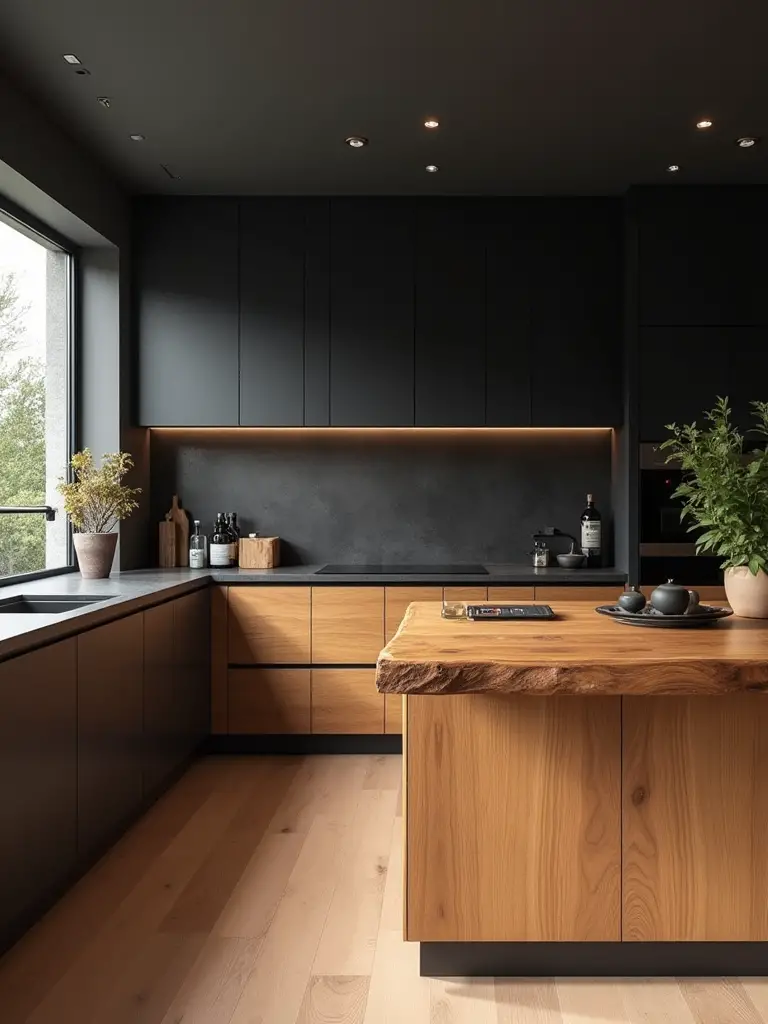
This doesn’t mean you need a rustic farmhouse look. The introduction of wood can be incredibly sophisticated. Think of a waterfall island wrapped in a warm, rift-sawn white oak. Or sleek, handleless upper cabinets in black, contrasted with lower cabinets in a rich walnut. Even something as simple as a set of open shelves in a light, natural wood or a few beautifully crafted wooden bar stools can provide that essential touch of warmth that makes the entire design feel complete.
And if you want to dial up that textural element even further, look to the walls.
13. Introduce Exposed Brick or Stone for Rustic Industrial Appeal
I’ll be blunt: if you don’t have an authentic brick wall in your home, please do not install a fake brick veneer. It will always look like what it is—a pale imitation. Authenticity is the cornerstone of luxury. However, if you are lucky enough to have original brick, embracing it in your kitchen design can be spectacular. The raw, ruddy texture of the brick against sleek black cabinets creates a dynamic tension between old and new, raw and refined.
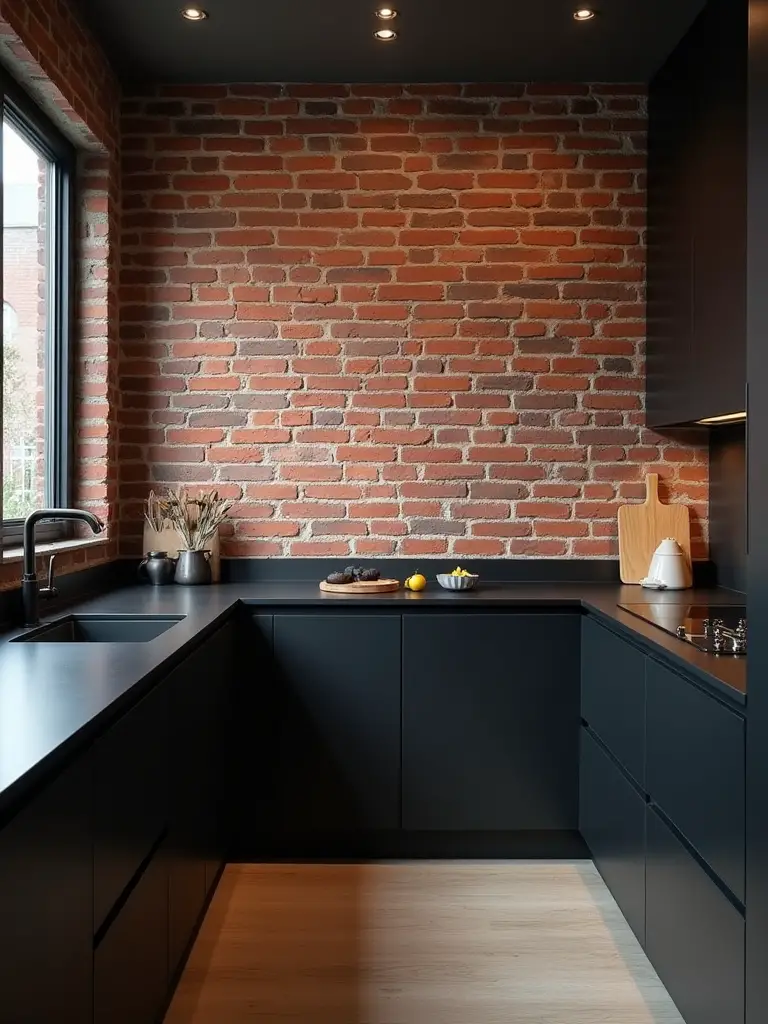
If you don’t have brick, you can achieve a similar textural effect with other materials. Consider a feature wall in Roman clay or a hand-troweled plaster finish, which has a soft, chalky texture and subtle movement. Even a wall of stacked slate or limestone can bring in that powerful, raw texture that prevents a black kitchen from feeling too perfect or impersonal. It’s about adding a touch of history and character.
Now, let’s look up and find the room’s sculpture.
14. Select Statement Hoods and Venting for Aesthetic Harmony
For years, the goal was to hide the range hood inside a cabinet. No more. In a modern Luxury kitchen, the hood is a sculptural opportunity. It is the perfect place to make a bold statement and create a central, organizing focal point for the entire room, especially over an island cooktop.
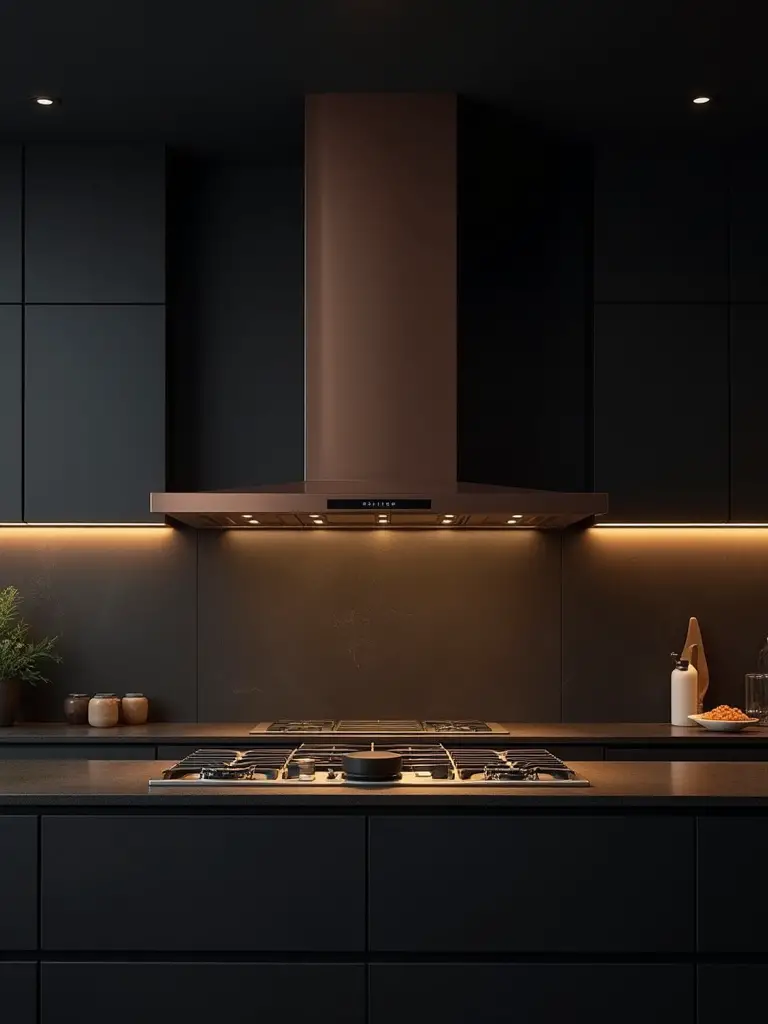
Instead of a standard stainless steel box, think about a custom hood. We can have one fabricated and clad in fluted metal, blackened steel, or even warm brass to match the hardware. A simple, boxy shape coated in a smooth, chalky plaster can be stunningly minimalist. This transforms a purely functional appliance into a deliberate, architectural element that anchors the entire design and draws the eye upward, enhancing the sense of height and volume in the room.
And at the other end of the functional spectrum, we find another opportunity for a sculptural moment.
15. Choose Unique Faucet Designs as Subtle Kitchen Focal Points
A faucet is one of the most hardworking pieces in your kitchen, but that doesn’t mean it has to be boring. In fact, it’s one of the best places to invest in a piece of high-design “sink jewelry.” A beautiful, thoughtfully chosen faucet can elevate the entire sink area from a purely utilitarian zone to a thing of beauty.
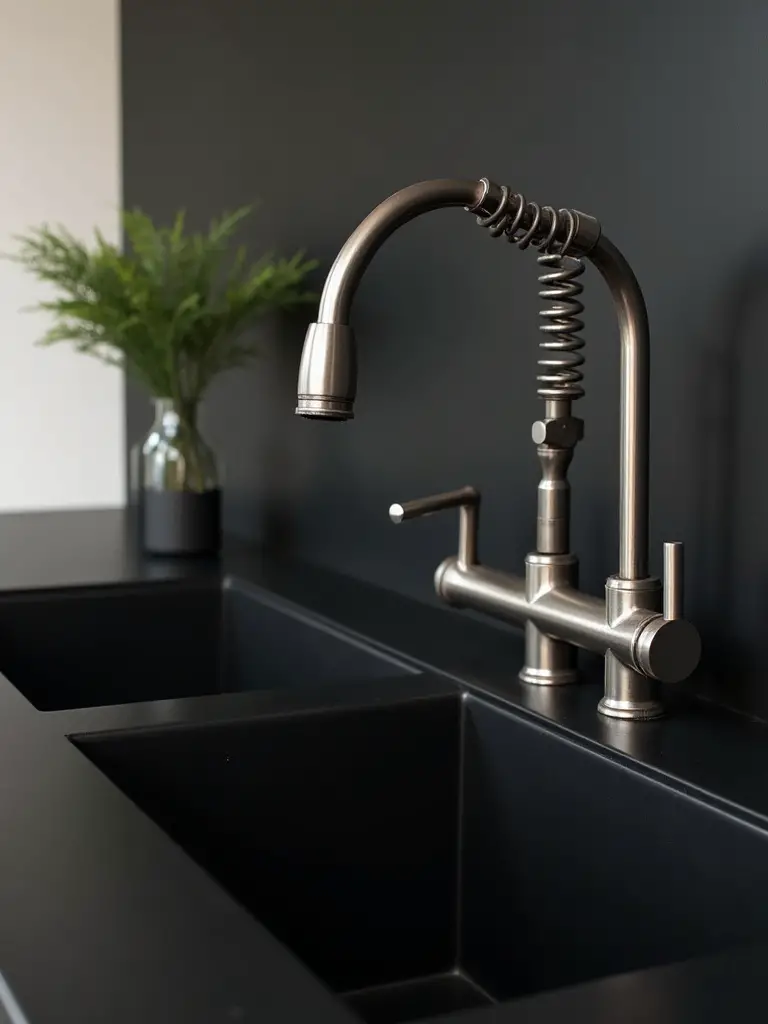
Look beyond the standard gooseneck models. Consider a bridge faucet for a classic, slightly industrial feel. Or an articulated, professional-style faucet with an exposed spring coil for an edgy, chef-inspired look. Brands like Kallista, Waterstone, and Brizo offer stunning designs in a range of finishes that feel more like sculpture than plumbing. Paired with an undermount sink, a striking faucet can become a subtle but powerful focal point that signals a deep attention to detail.
Finishing Touches: Styling & Personalizing Your Black Kitchen
We’ve built the room. Now, we make it yours. This is the final layer, where we infuse the space with personality, warmth, and life. These are the details that tell your story and transform a beautifully designed kitchen into the true heart of your home.
16. Curate Open Shelving Displays with Strategic Metallic Objects
Let’s have a little real talk about open shelving. It is not extra storage for your mismatched mugs and plastic containers. It is a stage. It is a curated, edited moment designed to add beauty and personality to your kitchen. The golden rule here is less is more. A cluttered open shelf will instantly make your entire kitchen feel chaotic.

The key to successful styling is a disciplined mix of materials. Group a small collection of white ceramic bowls with a single gleaming copper pot and a small, trailing plant in an earthenware pot. Use the rule of threes to create visually pleasing vignettes. The reflective quality of the metallics will bounce light around, while the organic shapes of the ceramics and plants will soften the hard lines of the kitchen. Think of it as a small, contained art installation.
And speaking of plants, they are an absolute necessity.
17. Add Lush Greenery and Plants to Inject Life and Freshness
A black kitchen, for all its sophistication, desperately needs life. Plants are the quickest and most effective way to provide it. The vibrant, organic green against a dark, dramatic backdrop is a classic pairing for a reason—it works. It breathes freshness and vitality into the space, preventing it from ever feeling stark or oppressive.
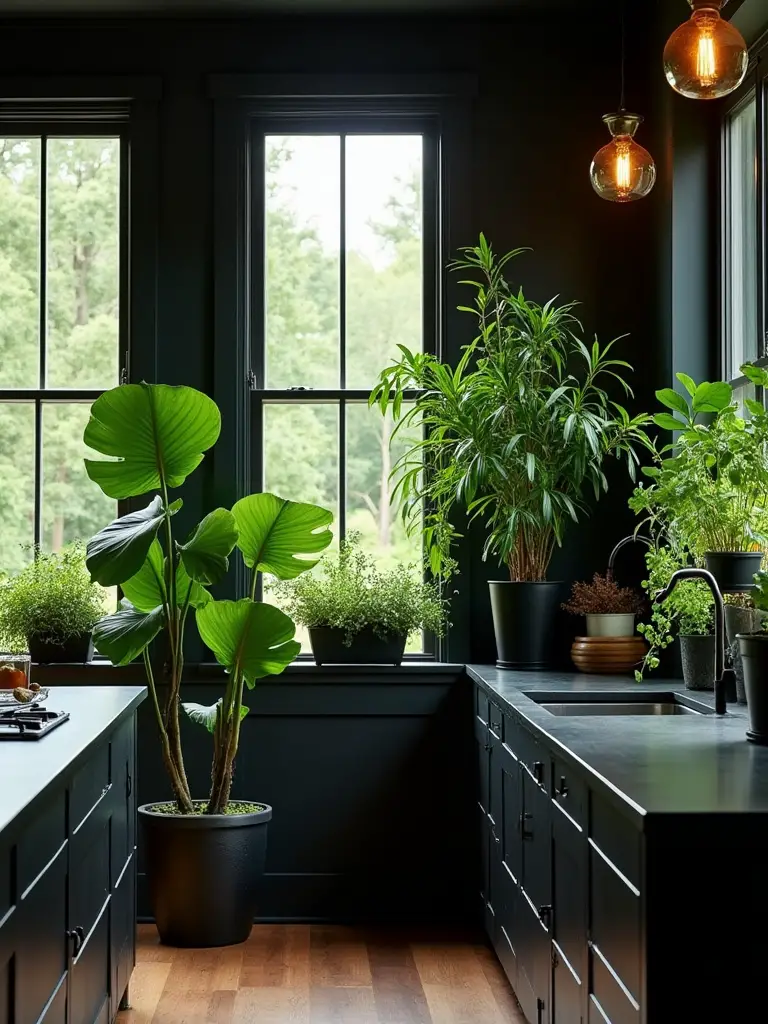
Don’t just plonk a small pot of basil on the windowsill. Think sculpturally. A tall, elegant Fiddle-Leaf Fig or Olive Tree in a beautiful pot in the corner of the room can act as a living piece of art. A small collection of herbs in a planter box on the island brings both life and function. And a trailing plant like a Pothos hung from a high shelf can add a lovely, cascading element. The greenery softens the edges and connects your sleek, modern interior to the natural world outside.
With that life in place, you now have the perfect canvas for your personal statement.
18. Select Artwork or Wall Murals to Personalize Your Dark Walls
Why should art be confined to the living room? A kitchen wall is a perfect canvas, and in a black kitchen, a piece of art can be a showstopping focal point. A large, bold piece of art is the perfect way to break up an expanse of dark wall, injecting color, personality, and emotion into the space.
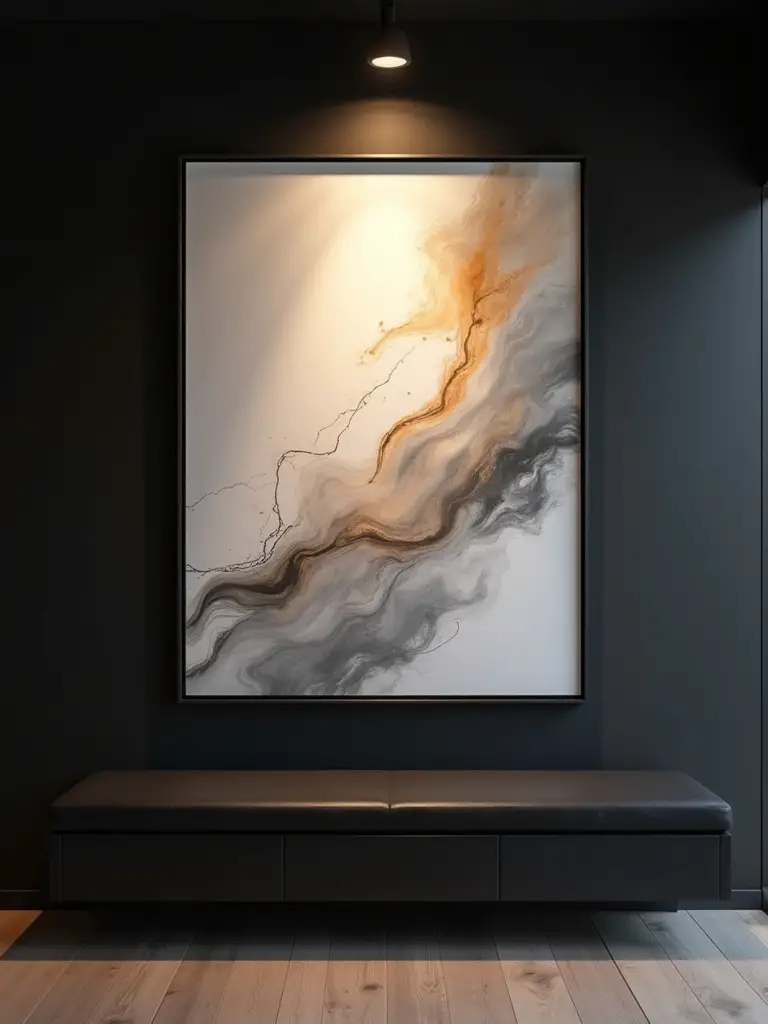
Don’t be timid. A massive abstract painting with flashes of bright color can bring incredible energy to the room. A large-scale, black-and-white photograph can enhance the sophisticated, gallery-like feel. If you’re truly bold, a custom wall mural can transform an entire wall into an immersive experience. And remember, the frame is just as important as the art itself. A simple, natural wood frame can add a touch of warmth, while a gilded frame can amp up the glamour.
Finally, let’s bring the function of this beautiful space into the 21st century.
19. Integrate Smart Home Technology Seamlessly for Modern Convenience
True luxury is when things work effortlessly. The best technology is the technology you don’t see. In a sleek black kitchen, the last thing you want is a mess of wires, gadgets, and screens cluttering up your beautiful countertops. The integration should be seamless and intuitive.

This means working with your electrician and cabinet maker from the beginning. Plan for in-cabinet charging stations for phones and tablets. Integrate smart switches that can be voice-activated to control your layered lighting scheme. Consider pop-up outlets that disappear into the countertop when not in use. The ultimate luxury is technology that anticipates your needs without ever intruding on the clean, minimalist aesthetic you’ve worked so hard to create.
Conclusion: Craft Your Black Kitchen Masterpiece
So, can you pull off a black kitchen? Absolutely. As you can see, creating a spectacular black kitchen has very little to do with simply choosing a paint color and everything to do with a thoughtful, layered approach. It is an exercise in balancing light and shadow, smooth and rough, warm and cool. It’s about creating a space that feels both dramatically sophisticated and deeply personal.
By embracing texture, strategizing contrast, and meticulously layering lighting, you can craft a space that is not just a trend, but a timeless statement of confidence. This is your chance to create more than just a room for cooking. It is an opportunity to design an experience—a space that inspires you every single day. Embrace the dark side. Your masterpiece awaits.
